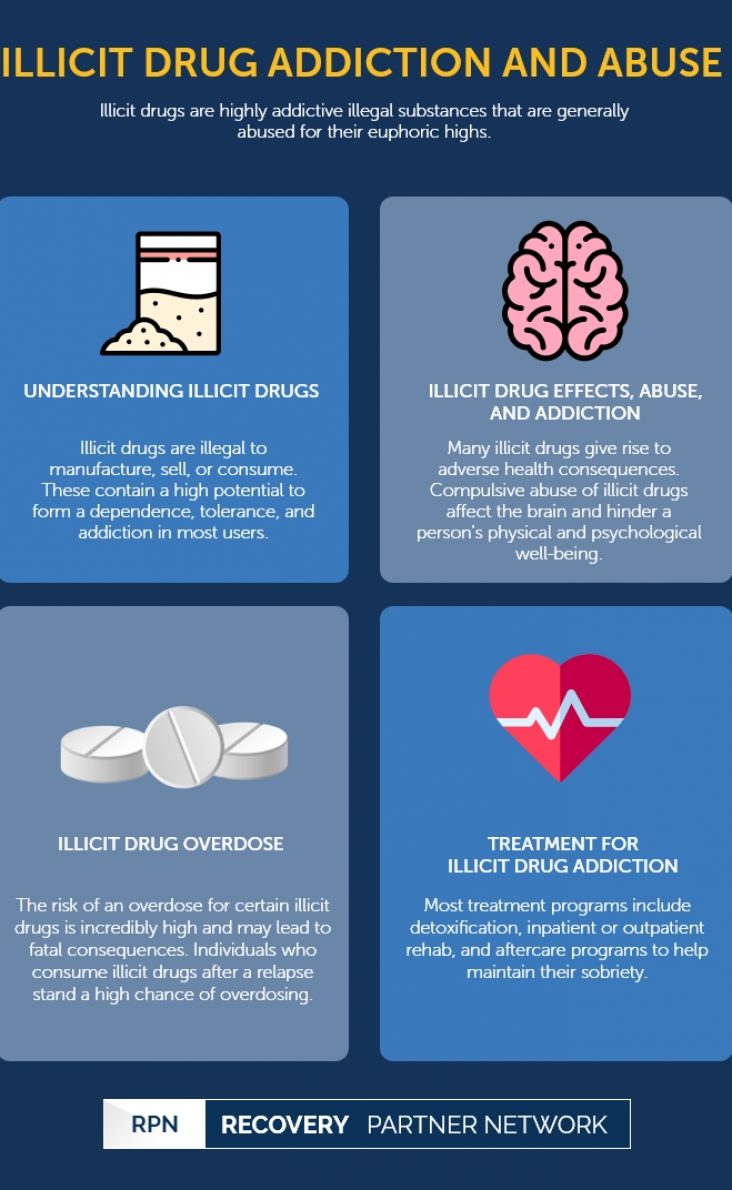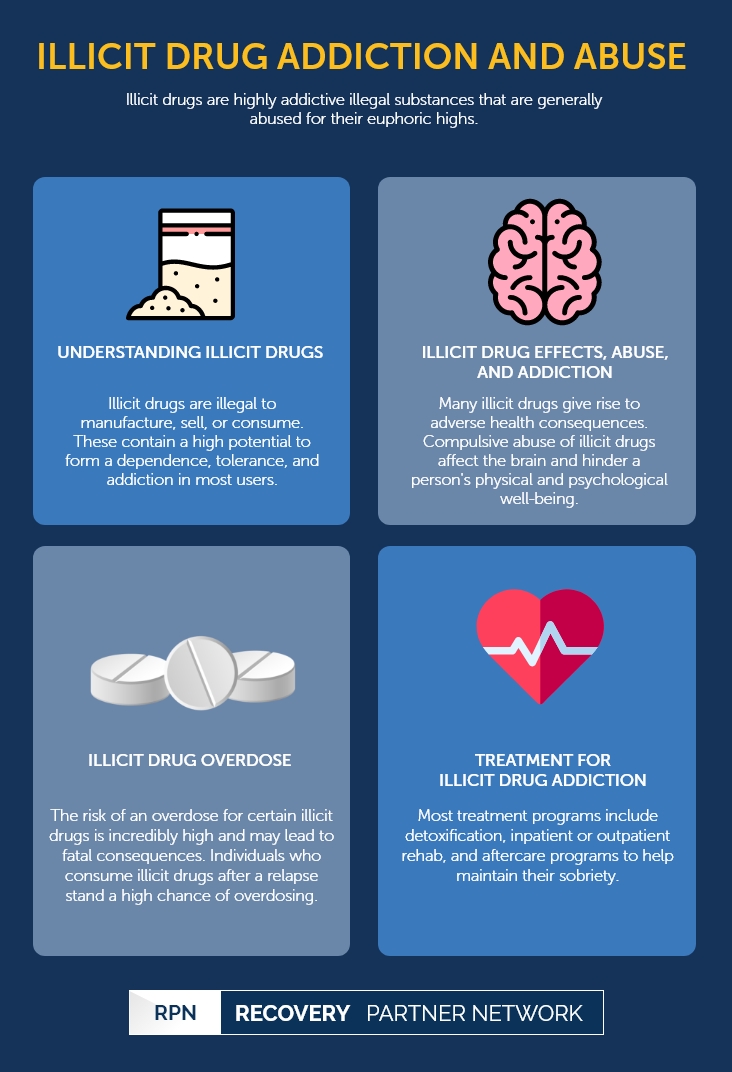Illicit drugs are highly addictive illegal substances that are generally abused for their euphoric highs.
Illicit Drug Addiction and Abuse
Illicit drugs
- Ayahuasca addiction – Abuse
- Baclofen addiction
- Black tar heroin addiction
- Cannabis addiction
- Cocaine dependence
- Crack cocaine addiction
- DMT addiction abuse treatment
- Does Marijuana Kill Brain Cells?
- Ecstasy addiction
- Gabapentin addiction
- gamma-Hydroxybutyric acid addiction
- Hallucinogen
- Heroin addiction
- Illicit drug addiction
- Inhalant addiction
- Cocaine
- Ketamine addiction
- Lysergic acid diethylamide addiction
- Mescaline addiction
- Methamphetamine addiction
- Meth Labs: Cooking up Addiction
- Meth Mouth
- Microdosing
- Phencyclidine addiction
- Psilocybin mushroom addiction
- Sage of the diviners – Addiction
- Shooting Heroin
- Shooting Methamphetamine
- Smoking Cannabis
- Speedball
- Synthetic cannabinoids
Illicit drug addiction | Table of Contents
Understanding Illicit Drugs
Illicit drugs are highly addictive substances, such as heroin, marijuana, and meth, that are illegal to manufacture, sell, or consume. Illicit drugs contain a high potential to form a dependence, tolerance, and addiction in most users. These drugs are generally consumed for recreational purposes due to their ability to induce euphoric highs. The rate of illicit drug abuse among individuals between 18 and 25 are among the highest recorded.
FAQ
- What are the most commonly used illicit drugs?
- What are the most expensive illicit drugs?
- What happens if you mix alcohol with illicit drugs?
The most expensive illicit drugs are heroin, oxycodone, and cocaine.
Alcohol can heighten the effects of illegal drugs and cause serious health complications ranging from nausea, heart failure, and overdose.
Most Common Illicit Drugs
- Cocaine
- Crack Cocaine
- Ecstasy
- Hallucinogens
- Heroin
- Inhalants
- Ketamine
- Marijuana
- Meth
- Synthetic Marijuana
Cocaine – is a potent and addictive stimulant produced from the South American cocoa plant leaves. This drug is generally available in powdered form. Street names of cocaine may include blow, bump, coke, and snow. Many users either snort the drug, smoke it (also known as freebasing), while some dissolve cocaine in water and inject it.
Well-known as the more pure and potent form of cocaine, crack cocaine is generally available in solid blocks or crystal forms. It is generally smoked to induce a short-lived but very intense high sensation. However, it is also the norm for certain individuals to use soda cans or aluminum foils to heat it and inject it directly.
Also referred to as a party drug or rave drug, it is most popular among high schoolers and young adults. Amplified sensory perception and lowered inhibition are few of the psychoactive effects of ecstasy. This drug is consumed as a pill orally, snorted, or dissolved in water and injected.
Are psychoactive or mind-altering drugs such as LSD, PCP, mushrooms, and salvia. Although the chances of developing an addiction to hallucinogens are comparatively low, the use and abuse of these drugs can cause adverse side effects.
Heroin is a highly addictive painkiller synthesized from morphine extracted from the seeds of the poppy plant. It is primarily available in white or brownish powder or as a black, sticky substance known as black tar. The drug is mostly injected, although it can be snorted, smoked, or taken orally.
Household items such as spray paints, markers, and cleaning suppliers inhaled through the mouth or nose to get high are known as inhalants. Some of these substances are highly toxic that could result in heart failure, seizures, and even death.
Ketamine predominantly used as an anesthetic in veterinary practice, ketamine can lead to hallucinations, sedation, and confusion when abused frequently.
Marijuana is a psychoactive drug widely used for recreational and medical purposes with a high potential for developing psychological dependence with long–term use. Its main psychoactive ingredient, Tetrahydrocannabinol (THC,) causes temporary euphoria, followed by drowsiness, slowed reaction time, and increased appetite.
Meth is a dangerously potent stimulant powerful enough to cause an instant addiction after a single-use. Prolonged consumption of this drug can result in violent behavior, severe dental problems, psychosis, and extreme paranoia.
Refers to the wide range of manufactured substances that contain chemicals similar to THC. Although these drugs are promoted as the more legal alternative, their effects are highly unpredictable and intense compared to their natural counterpart.
Illicit Drug Effects, Abuse, and Addiction
Many illicit drugs give rise to adverse health risks, even when ingested in small quantities. Repeated use of any illicit drug can result in short- or long-term consequences. Compulsive substance use leads to dramatic changes in the brain, which can then hinder a person’s psychological well-being. These changes will drive a person to behave irrationally, eccentrically, or unusually, leading them towards self-destructive decisions such as driving under the drug’s influence.
Common signs of substance abuse are:
- Abrupt, unusual surge or depression of energy levels.
- Display of aggressive behaviors or violent mood swings.
- Occupied with purchasing and consuming the drugs.
- Secluded from friends or family.
- Developing friendships with the new, more suspicious type of people.
- Only willing to attend events where drugs are present.
- Continual use of the drug despite its physical risks.
- Exhibiting behaviors that violate personal morals to obtain or use drugs.
- Facing legal or professional consequences due to illicit drug use, such as getting arrested or losing a job.
The telltale sign of a substance abuse disorder is physical dependence, which can be recognized by the build-up of tolerance and dependence to the drug. Tolerance begins when an individual requires more and more of the drug to enjoy the desired effects. The formation of dependence may cause individuals to experience intense and severe withdrawal symptoms when they try to quit the habit or reduce their dosage.
Withdrawal symptoms can range from mild to severe and may include heart palpitations and seizures, depending on the type of drug ingested. Although some illicit drugs can cause the formation of psychological dependence or physical dependence, some hold the capacity to cause both simultaneously.
Recognizing the Signs of Illicit Drug Addiction or Abuse
The addiction to illicit substances modifies the way a person’s brain functions, and as a result, alters an individual’s behavior and mentality.
Signs of stimulant abuse may include:
- Diseases related to vitamin deficiencies and malnutrition
- Skin disorders or ulcers
- Insomnia
- Increased blood pressure or body temperature
- Weight loss
- Depression
- Consistently dilated pupils
Signs of heroin abuse may include:
- Chills
- Muscle aches
- Nausea
- Drowsy or tired
Signs of hallucinogen abuse may include:
- Dilated pupils
- Unco-ordinated movements
- Nausea or vomiting
- High blood pressure
- Dizziness
- Suicidal thoughts
- Violent behavior
Illicit Drug Overdose
The risk of an overdose for certain illicit drugs is incredibly high, as they could lead to fatal consequences. Individuals who relapse after maintaining their sobriety tend to hold an increased chance of experiencing an overdose, as their body gradually adapts itself to no longer relying on the drug. The consumption of high doses as previously accustomed to can lead to an unfortunate overdose. This is generally the case for individuals who inject illicit substances. Heroin is one such drug that possesses a high potential to cause relapse and overdose. There has been a spike in the number of heroin and other opioid-related deaths in the last decade. From 2002 to 2017, the number of deaths related to opioids increased by four-folds.
FAQ
The most dangerous illicit drugs are heroin, cocaine, oxycodone, fentanyl, and morphine.
Illicit drugs are generally mixed, cut, or combined with other substances that may sometimes be lethal. This makes the effects of illicit drugs highly volatile and dangerous.
Illicit Drug Abuse Statistics
- As estimated, 23.9 million Americans aged 12 or older (9.2 percent of the population) had indulged in an illicit drug in the previous month before a 2012 study. This rate of illicit drug use is the highest amongst individuals aged 19 to 25.
- A 2013 report identified a drastic increase of 19.8 million marijuana use in individuals who were 12 and above compared to 14.5 million in 2007.
- An estimation of meth abuse in the United States skyrocketed from 353,000 in 2010 to 595,000 in 2013.
- From the 2.8 million individuals who used illicit drugs for the first time in 2013, 54 percent were under the age of 18.
Treatment for Illicit Drug Addiction
The initial stage of any addiction treatment is detoxification. Depending on the illicit drug used and the severity of one’s addiction, patients will under a detox option that is best suited for them. Medically assisted or the tapering down method is the two most common methods of detox for illicit drug addiction.
After the successful completion of detoxification, patients must undergo treatment at an inpatient or outpatient treatment center. Theses centers help patients overcome their psychological dependence on the drug. At a typical inpatient rehab center, mental health professionals will strive to discover the root cause of substance abuse, such as co-occurring mental health disorders. In addition, patients will also be educated on relapse prevention skills such as healthy coping habits that could help achieve long term recovery.
After the completion of inpatient or outpatient treatment programs, patients must seek aftercare programs or ongoing treatment programs to help maintain their sobriety and decrease their chances of a relapse.
Recovery Partner Network
We aim to educate and empower. If you feel our library of resources does not cover your specific need, reach out to us, and we would be happy to help.
STATISTICS
© Copyright 2024


